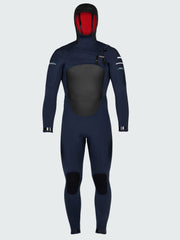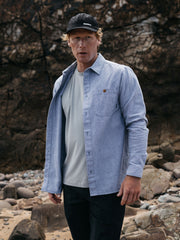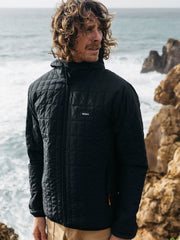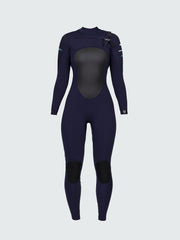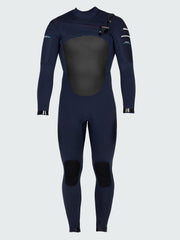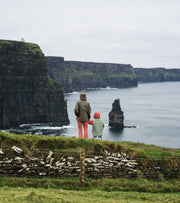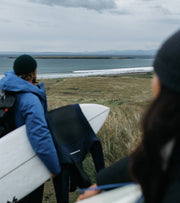Bound by blood, separated by salt and stone. Venturing across the channel in search of cold uncrowded lineups, Ambassador Mike Lay explores the deep-rooted Celtic connections between his Cornish home and the ancient coastline of Brittany.
A Celtic Connection
18.01.24
4 min read
Written by Mike Lay
Photography by Luke Gartside
A splintered jag of ripped granite splits the sea, and a spell is cast...
South is the maelstrom. All the fury of winter's first howl, wave dragging over raging wave with sights set on land. Gulls whirl with the calm of the centre of a storm in each cunning eye. The wind reigns chaotic, warning and imploring through the lichen-clad crags, ripping across the massive sky.
To the north, past that bewildering line, the sea breathes a smooth sigh, helped by the retreating tide, becalmed. It is so drastic a shift that it might as well be magic. Some rip in the fabric of this world and a window into another where no storm blows.
Baie des Trépassés (Bae an Anaon in Breton) is an open-armed swathe of rock and sand flanked by the outstretched arms of the southern Pointe de Raz (Beg ar Raz) and northern Pointe de Van (Beg ar Vann). We had driven north from the cultural heart of Breton surfing, La Torche, in search of shelter from a large south swell and south west wind. Baie des Trépassés was sheltered enough from the swell, the magic at the Pointe de Raz ensured that, but was still bedraggled by the wind, like someone arriving home after a walk in a storm.
The English translation of Baie des Trépassés is "Bay of the Dead". It is said, this was the place where the bodies of deceased Druids would leave the mainland on a last voyage towards their final resting place on the Île de Sein (Enez-Sun in Breton), a small archipelago 8km west of the mainland. On these islands it is also said that a particular druidic sect once lived, the Gallizenae. Mentioned by both Greek and Roman historians and travellers, the female Druids of the Gallizenae had the power to rouse both the wind and the sea as well as being able to transform into any animal they wished.
My disbelief was easily suspended in this mystical place. Even with a basic knowledge of tide, wind, swell and bathymetry, it is easy to see how such stories came to be. Surely these druidic women would have been birds, of all the animals in the world? On the southern side of the point we watched gulls fish in the most violent of seas, while in the northern lee of the rocks a small host of sparrows flitted from ledge to ledge.
Then, shooting up as if from the the sea itself, amidst the chaos of everything, Seth spotted a peregrine falcon. It climbed to a great height and hung in the air, almost exactly in the middle of these two polar seas, looking down, as a puppeteer might, on the jostling world. A master of both the fury and the calm, the peregrine seemed to be made of something different. If a druidic presence had indeed visited from Enez-Sun, then surely this was she – one moment still, the next tucked in and falling impossibly fast, like a dropped stone to a well, before wheeling round at the last moment and flying up to meet the howling torrent of the wind.
This is the end of the land in a place known to be the end of the land. Although not technically the most westerly point in Brittany or France (that accolade goes to a less dramatic kink in the land further north) it is certainly the end of the land in spirit. Beyond the predictable trappings of such auspicious places (inflated parking charges and several shops worth of trinkets), there are more familiar signs of reverence for the remote. The land of Finistère shares much with my own westward-jutting peninsular, from their Brythonic names (Penn ar Bed: End of the World, or Penn an Wlas: End of the Country) to a shared affinity for agriculture and the sea. Indeed the region of Finistère in which we spent most of our time was called Cornouaille, or Cornwall, a name which stemmed from Cornish settlers coming to live with their brothers and sisters in Brittany in the first few centuries AD, after Anglo-Saxons colonised the island of Britain in the wake of the Roman withdrawal.
Looking further back, the landscapes are similarly punctuated with dolmens and menhirs. The neolithic people of Brittany and the neolithic people of Cornwall stood stones up to stand, and stand they still do. On headlands and moorlands, in oak woods and, now, unceremoniously tucked between the houses of countless Breton towns. We do not know why they did so, there is no written record, no evidence, but in their presence it feels like we should know. There is a memory of observance, of bearing witness, of holding space. Better even than the oldest oak, can these stones watch the world, watch tides strobe while storms pass in less than the blink of an eye. If nothing more they are the watchers of the wheel of time.
Back at the Baie des Trépassés, we chose calm and the north and gambled on a slither of sheltered sand. The elements aligned, as they sometimes do, the tide dropped a little and the storm-beaten sea brushed itself down. Small waves bounced off the eastern cliff and, for an hour or so, groomed blue rights spun across the narrow bay.
I surfed by myself and marvelled at the feeling of home, so strong that I could have been anywhere in Cornwall. The tide turned and filled in enough to send the water wobbling again, so I called it a day. And as I changed, a man in the only other vehicle in the tiny carpark plucked at a violin while his partner sang.


































